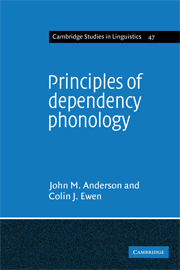
-
Select format
-
- Publisher:
- Cambridge University Press
- Publication date:
- August 2010
- August 1987
- ISBN:
- 9780511753442
- 9780521113236
- Dimensions:
- Weight & Pages:
- Dimensions:
- (229 x 152 mm)
- Weight & Pages:
- 0.48kg, 324 Pages
You may already have access via personal or institutional login
Book description
John Anderson and Colin Ewen, two of the most notable exponents of 'dependency phonology', present in this book a detailed account of this integrated model for the representational of segmental and suprasegmental structure in phonology. Dependency phonology departs from traditional 'linear' models of phonology, and the more recent non-linear models of autosegmental and metrical phonology, in several respects. Unlike in these models, suprasegmental structure is derived directly from the segmental representations, and these representations are based on single-valued features, or components (rather than Chomsky and Halle-type binary features), linked by the dependency relation to form suprasegmental structures, with the exact nature of the dependency relations being directly determined by the properties of the segmental structure. Phonology is currently noteworthy for the diversity of views within the discipline, but no linguist or phonetician with a serious interest in phonology can afford to ignore this book or fail to be interested by it.
Contents
Metrics
Full text views
Full text views help Loading metrics...
Loading metrics...
* Views captured on Cambridge Core between #date#. This data will be updated every 24 hours.
Usage data cannot currently be displayed.
Accessibility standard: Unknown
Why this information is here
This section outlines the accessibility features of this content - including support for screen readers, full keyboard navigation and high-contrast display options. This may not be relevant for you.
Accessibility Information
Accessibility compliance for the PDF of this book is currently unknown and may be updated in the future.


